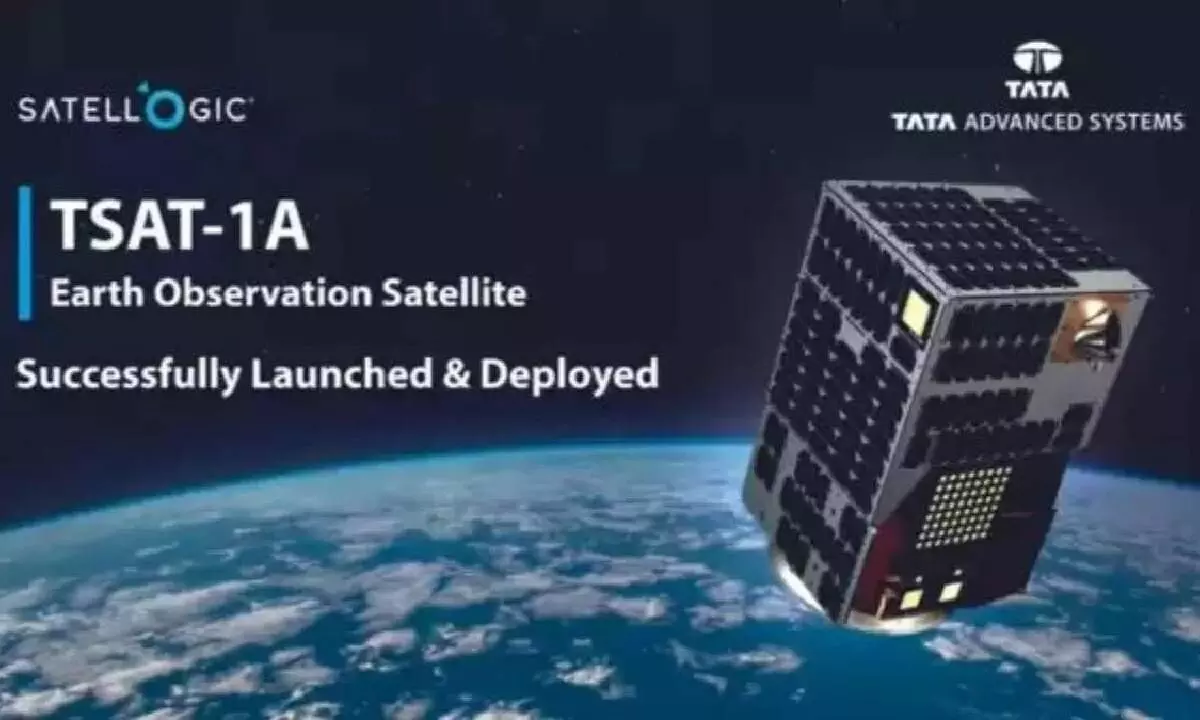Leveraging private industry to meet space-related military needs is a timely move
TASL's plans a constellation of similar satellites and around 25 low earth orbit satellites annually
image for illustrative purpose

In what can mark a major stride for the domestic space sector, the first private military-grade satellite, the TSAT-1A, was successfully launched earlier this month, thanks to Tata Advanced Systems Ltd (TASL), which developed the satellite.
TSAT-1A was part of the Bandwagon-1 mission launched by SpaceX's Falcon 9 rocket from the Kennedy Space Center in Florida. TASL's announcement on April 8 marked a major advancement in the field of space technology.
The TSAT-1A, a lightweight satellite weighing less than 50 kg, is currently orbiting the earth in low-earth orbit. It boasts high-resolution imagery capabilities with incredible precision, offering less than one metre per pixel. TASL officials have confirmed that the satellite has entered the designated orbit and will undergo thorough testing to ensure its full functionality over the coming weeks.
With the TSAT-1A, TASL aims to serve the government and armed forces with top-quality military-grade images. The company is also planning to venture into the commercial market, showcasing its forward-thinking approach and adaptability. To ensure seamless data download and processing, it is actively working on establishing a ground centre in India, a move that signals its readiness for the future.
While India's military spy satellite fleet, developed by ISRO, is currently limited in number, TASL's plans to establish a constellation of similar satellites in the future and produce up to 25 low earth orbit (LEO) satellites annually from its manufacturing facility could revolutionize the country's space sector. These satellites are being crafted in partnership with Satellogic Inc., a leading name in sub-metre resolution earth observation satellites.
Indian military space era:
India is increasingly relying on US-based companies for their spy imaging needs due to the limited application and extensive coverage required by the satellites operated by ISRO. The recent conflicts with China along the Line of Actual Control (LAC) have further emphasised the need for this. To obtain imagery, the armed forces have to provide precise coordinates and timings to foreign vendors. However, the Indian armed forces require more Earth Observation (EO) satellites with higher temporal resolution. EO involves utilising remote sensing technologies to monitor land, marine (seas, rivers, lakes), and atmosphere. In response to the ongoing tensions with China, India has launched a series of radar imaging satellites (RISAT) for border surveillance, enabling them to obtain high-resolution spot images.
It has been reported that China currently operates 136 reconnaissance satellites as of 2022, a significant increase from 66 in 2019. In contrast, India's number of satellites is significantly lower. Against this backdrop, the launch of India's first private spy satellite is an important milestone. Furthermore, it is noteworthy that India is placing great emphasis on utilising space for military purposes. The satellites will keep track of the enemy's mobilisation and troop movements and be used for satellite-linked unmanned aerial vehicles that will be added to the Indian Armed Forces' fleet. This marks a crucial development for India, which has been leveraging its private industry to meet its growing space-related requirements.
It has been reported that the Indian armed forces will soon have access to a dedicated satellite network. Last year, the Ministry of Defence signed a contract worth Rs. 2963 crore with New Space India Limited (NSIL), the commercial arm of ISRO, for the development of the Geostationary Satellite (GSAT)-7B.
This advanced communications satellite will be exclusively used by the Indian Army to manage intra- and inter-service communication in network-centric warfare. The GSAT-7B was granted Acceptance of Necessity (AoN) under the Buy Indian (Indigenously Designed, Developed, and Manufactured-IDDM) category by the Indian Defense Acquisition Council in 2022.
The Indian army has thoroughly analysed network-centric warfare and standalone cyber, communications, and electronic warfare systems utilised in the Russia-Ukraine conflict.
Now the army has proposed establishment of a secure and robust satellite communication system to connect forces deployed in the field with their headquarters stationed in the interior. A violent confrontation with China triggered this proposal, and the army is actively considering implementing this system.
The GSAT-7B, which is expected to be deployed by 2026, will be the first-ever satellite in the five-ton category that has been indigenously designed, developed, and manufactured, providing the army with the ability to see beyond the horizon.
Today, India has only two dedicated military satellites- GSAT-7 (Rukmini) and GSAT-7A (Angry Bird) - used by the Indian Navy and Air Force, respectively.
The Indian army has been relying on GSAT-7A and other surveillance satellites, such as RISAT 2BR1, for its communication and surveillance operations. On the other hand, the navy has been utilising Rukmini since 2013. It has a wide range and covers nearly 2,000 nautical miles in the Indian Ocean region. The IAF launched Angry Bird in 2018, significantly improving connectivity between ground radar stations, airbases, and airborne early warning and control aircraft. Moreover, it also contributes to the efficient satellite-controlled operations of UAVs.
Mission DefSpace:
In recent years, the Indian government has taken significant steps to promote private participation in space activities. This includes setting up the IN-SPACe agency to authorise and monitor private entities in the space sector.
Additionally, the introduction of new guidelines and policies, such as the National Geospatial Policy-2022 and the New Telecommunications Act 2023, has created a favourable environment for growth in the industry.
The recently announced Mission DefSpace has further expanded the role of the private sector in national defence, creating opportunities for private companies to participate in related space activities. This initiative not only boosts the space industry but also aligns with national security objectives, making it a win-win for all parties involved.
(The writer is a journalist who writes on defence, strategic affairs and technology)

